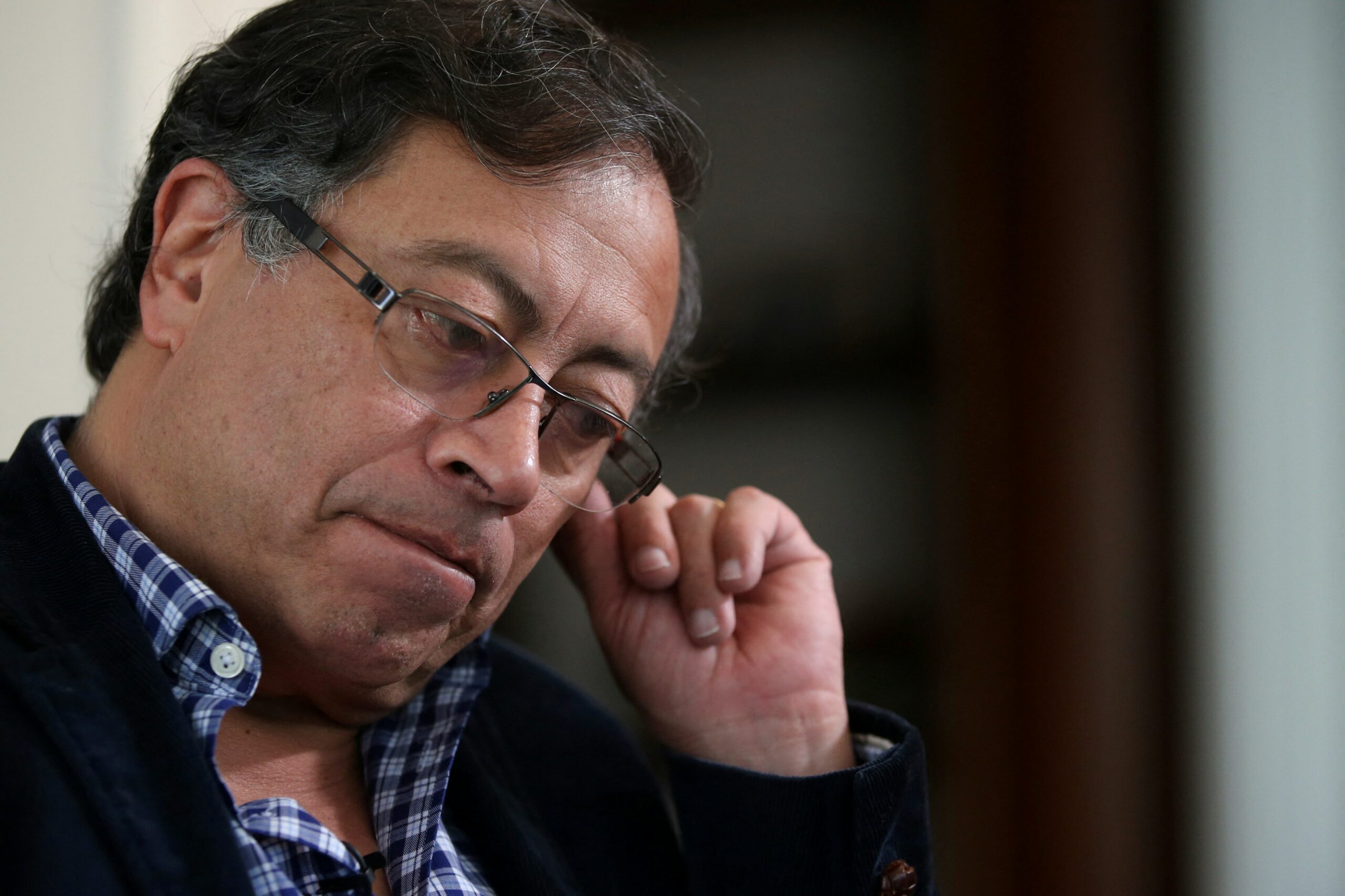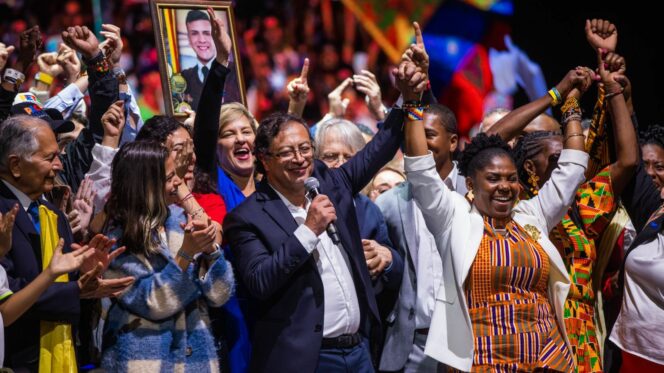Can Colombia’s New President End the War on Drugs?
This could be the end of the line for Colombian cocaine.
by Niko Vorobyov
27 June 2022

Last week, Colombia made history. The conservative South American country elected a former rebel as its first progressive president. Gustavo Petro, a former militant of the M-19 guerrilla movement, champions the poor and the planet.
For many, Petro’s victory couldn’t come quickly enough. Dozens died in battles with the police last year as Colombians hit the streets in mass protests against corruption, inequality, ecological catastrophe and the collapsing peace process under the hard-right government of Iván Duque. One common thread connecting these ills is a disastrous campaign, led from Washington: the war on drugs. Can Petro bring an end to years of bloodshed?
Decades of drug war.
Cocaine has been synonymous with Colombia since the late 1970s, when prohibition allowed Pablo Escobar and his pals to become stinking rich. The white stuff comes from the leaves of the coca plant, the majority of which is secretly grown in three countries: Colombia, Bolivia and Peru. It only costs several hundred dollars to buy a kilo from a peasant farmer, but by the time the powder is smuggled from the jungles of the Andes to nostrils in the likes of Europe and North America, that price can climb tenfold, making it a worthwhile investment for underworld kingpins the world over.
Since the 1960s, Colombia – the world’s largest producer of cocaine – has been facing a Marxist insurgency interested in the redistribution of wealth. To protect their ill-gotten fortunes, Escobar and the other coke barons hired their own private armies trained by Israeli mercenaries. As well as targeting Marxist rebels such as FARC (the Revolutionary Armed Forces of Colombia) and M-19, these gunslingers could be called on to deal with trade unionists, business competitors and judges. Escobar’s hometown of Medellín became one of the deadliest cities on Earth, averaging 7,000 murders a year, with Colombia additionally under attack via the imported violence of America’s war on drugs.
In the end, Escobar was gunned down on a Medellín rooftop, but the paramilitary structures he created stayed in place, spawning gangs such as the infamous Gulf Clan. Calling themselves ‘self-defence forces’, they used anti-communism as a front for drug trafficking, extortion and general thuggery on behalf of the ruling class like landowners and politicians. When the hard-right Álvaro Uribe became president of Colombia in 2002, the paramilitaries tightened their grip on power. The guerrillas, meanwhile, cashed in on the cocaine bonanza themselves. Coke-dealing communists again attracted Washington’s attention, and starting with Bill Clinton, Plan Colombia lavished the military with billions of dollars for counternarcotics, counterinsurgency, and Black Hawk helicopters.
More than a quarter-million Colombians have been left dead in almost six decades of conflict, nearly half at the hands of rightwing paramilitaries. Yet after billions of dollars and hundreds of thousands of lives, the UN estimates that Colombia exported a record 1,228 metric tonnes of cocaine in 2020 – more than twice what it was churning out at the turn of the century. As part of a peace deal with FARC rebels four years earlier, the government was supposed to provide farmers with other crops they could grow. They never made good on their pledge, and farmers had little choice but to return to coca. The recently demobilised FARC rebels, too, feel betrayed by their government not holding up its end of the peace deal, and many have taken arms again, joining the numerous armed bands terrorising the countryside.
The land itself is also being poisoned by the drug war. Rather than risk straying into rebel territory, the drug warriors have begun spraying coca fields from the air with glyphosate, a weedkiller that poisons not only the coca but also the soil around it and legitimate crops like bananas and plantains, wrecking the peasants’ livelihoods. It’s rarely mentioned how coca is the single most worthwhile crop for impoverished Colombian farmers, putting children through school and food on the table.
A new hope?
Former presidents César Gaviria, who led Colombia in Escobar’s era, and Juan Manuel Santos, have spoken out against what the drug war has done to their homeland: endless war, corruption and suffering. Now hopes of peace lie with Petro. But where should he begin?
As a congressman, Petro held hearings that exposed cosy relations between paramilitaries and politicians. As a presidential candidate, he’s been critical of extradition to America, where paramilitary warlords like Gulf Clan boss Otoniel can escape justice by pleading guilty to drug charges. Whereas in the past, narco-barons wanted anything but an American prison cell (Escobar even went to war over it), now it’s an easy way to start a new life. And since American authorities only prosecute drug lords based on their trafficking, and not on all the villagers they may have murdered, prison sentences have the potential to be lesser than in Colombia.
As it stands, Colombia is helping America arrest its way out of a public health crisis (another failed policy) at the expense of peace, justice and reconciliation at home. An end to extradition could reverse that – and signal a break with overt US dictation of Colombian policy.
On the production front, Petro seems to be leaning away from continued prohibition, bolstered by environmental factors. In 2015, glyphosate was recognised as carcinogenic, leading then-president Juan Manuel Santos to suspend spraying. Petro is unlikely to resume the practice, and wants to stop deploying the army to get rid of coca, which only pushes farms deeper into the jungle. But he goes further. Petro’s suggestion is to replace the coca fields with marijuana, giving the farmers other opportunities to earn a living (medical cannabis is already allowed in Colombia, and Petro has indicated he wants to allow it recreationally).
The rejoinder to this plan is that crop substitution rarely meets growers’ needs. Coca can be harvested three to four times a year and there’s a consistent demand for it, unlike, say, coffee and other lawful crops, where neoliberal economics pits local farmers against cheaper overseas competitors. Since everyone from California tech bros to the Taliban are trying to cash in on the green gold rush, will Colombia’s produce really stand out?
Even if marijuana brings enough income to poor peasant farmers, the demand for cocaine remains. There’s a gap in the market waiting to be filled. This is what’s known as the balloon effect: if you squeeze the balloon (i.e. the drug business) in one spot, it simply expands somewhere else. In other words, if Colombians won’t grow enough coca, somebody else will; as well as Peru and Bolivia, coca farms have lately been spotted in Honduras. Petro won’t have solved anything, only made it somebody else’s problem.
Legalising lines.
There is another way. In 2020, a group of opposition senators in Colombia put forward a bill legalising cocaine. Coca leaves (which have a very mild high) and tea would be sold freely, as they are already in Bolivia and Peru. In the mid-2000s, Bolivia began allowing households to cultivate their own coca, which is closely monitored by the local growers’ union. If they go over their quota or part of their harvest “disappears”, they’ll have some explaining to do or lose their privileges. Unlike Colombia, Bolivia no longer has any cocaine-funded warlords and in fact is among the safer countries in Latin America.
Under the plans proposed in Colombia, powder cocaine would be rationed to registered adults at pharmacies. Only local and Indigenous farmers would be allowed to grow in designated areas, (excluding protected nature reserves) selling to a government monopoly. A state-run monopoly taking profit out of the equation will help avoid the mistakes that have allowed Big Pharma, alcohol and tobacco giants, to claim millions of lives through irresponsible corporate greed.
The bill was shelved by conservative lawmakers. So far, Petro hasn’t talked about lifting the ban on cocaine as he has for cannabis, but given his criticism of the drug war, the proposals might warrant a second look.
Legalising cocaine won’t end organised crime, but it will move Colombia towards peace. After all, contemporary American breweries don’t get into shootouts over who gets to sell booze in which bar – that only happened during the Prohibition era. Escobar was just Al Capone on a much bigger scale.
If Petro ends the war on drugs, he’ll have to challenge very powerful, interested parties, ones willing to kill to protect their business model. Then of course there are all those who want to keep drugs illegal: concerned mums, moral crusaders, and hard-nosed narcs. Since Plan Colombia, Colombia is the third-major beneficiary of American military aid, and will likely lose a lot of those handouts if it refuses to play ball. Bolivia discovered that the hard way when it kicked out the DEA, legalised coca, and was branded a rogue state.
I’m reminded of what another Latin American guerrilla-turned president José ‘Pepe’ Mujica said all the way back in 2013, when he led Uruguay to legalise cannabis: “Someone has to be the first”.
Niko Vorobyov is the author of Dopeworld.


